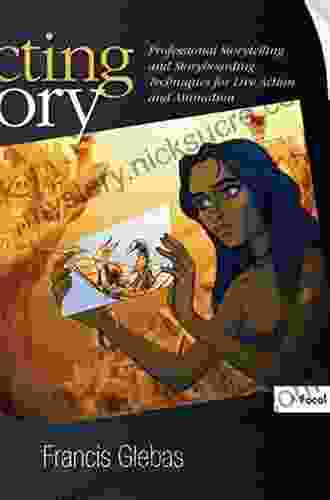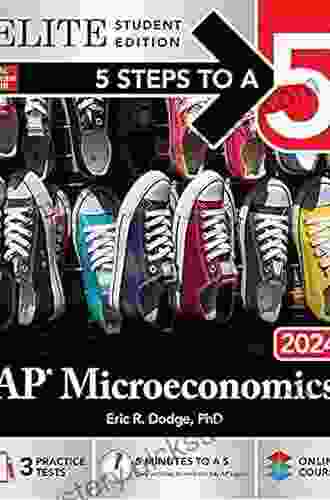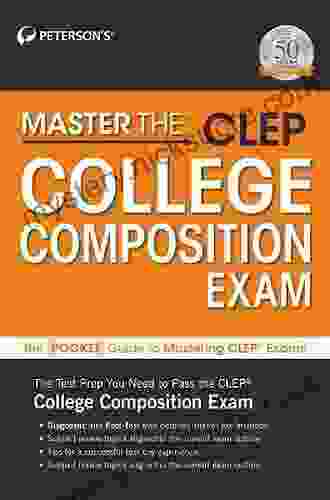Professional Storytelling and Storyboarding Techniques for Live Action

Storytelling is an essential aspect of filmmaking, and storyboarding is a crucial tool for bringing stories to life. In this guide, we'll explore the art of professional storytelling and storyboarding techniques specifically for live action projects.
Whether you're a seasoned filmmaker or just starting out, understanding these techniques will empower you to create engaging and emotionally resonant visual narratives that captivate your audience.
4.7 out of 5
| Language | : | English |
| File size | : | 52377 KB |
| Text-to-Speech | : | Enabled |
| Screen Reader | : | Supported |
| Enhanced typesetting | : | Enabled |
| Print length | : | 353 pages |
1. Script Analysis: Understanding the Story's Blueprint
The first step in the storytelling process is a thorough analysis of the script. This involves breaking down the story into its core elements, including:
- Plot: The sequence of events that drive the story forward.
- Characters: The individuals who inhabit the story and drive its conflict.
- Theme: The underlying message or idea that the story conveys.
- Setting: The time and place in which the story takes place.
- Tone: The emotional atmosphere and style of the story.
By understanding these elements, you can begin to visualize the story and identify the key moments that need to be captured on screen.
2. Storyboarding: Translating the Vision into Visuals
Once you have a clear understanding of the script, the next step is to create a storyboard. A storyboard is a series of sequential drawings that illustrate the key shots of the film.
Each storyboard panel should include the following information:
- Panel Number: The order in which the panel appears in the storyboard.
- Shot Description: A brief description of the action taking place in the shot.
- Camera Angle: The angle from which the shot is being taken.
- Lens: The type of lens being used (e.g., wide-angle, telephoto).
- Camera Movement: Any camera movements, such as pans, tilts, or zooms.
- Characters and Props: A list of the characters and props that appear in the shot.
- Dialogue: Any dialogue that is spoken in the shot.
By creating a storyboard, you can visualize the flow of the film and identify any potential problems with the script or staging.
3. Shot Composition: Framing Your Narrative
Shot composition refers to the arrangement of elements within a frame to create a visually engaging and meaningful image.
When composing shots for live action, consider the following elements:
- Rule of Thirds: Divide the frame into thirds horizontally and vertically. The most important elements of the shot should be placed along these lines or at their intersections.
- Leading Lines: Use lines within the frame to draw the viewer's eye to the subject.
- Depth of Field: Control the depth of field to focus the viewer's attention on specific elements.
- Camera Angles: Experiment with different camera angles to create different perspectives and emotional effects.
- Movement: Use camera movement to create a sense of dynamism and energy.
By mastering shot composition, you can create visually stunning and impactful images that tell your story effectively.
4. Lighting: Shaping the Mood and Atmosphere
Lighting plays a crucial role in setting the mood and atmosphere of a film. By manipulating the quality, direction, and intensity of light, you can enhance the emotional impact of your story.
Consider the following lighting techniques:
- Natural Lighting: Utilize natural light sources, such as the sun or moon, to create a realistic and naturalistic look.
- Artificial Lighting: Use artificial light sources, such as spotlights or lamps, to create specific moods and atmospheres.
- Three-Point Lighting: A common lighting setup that uses three light sources to illuminate the subject from different angles.
- High-Key Lighting: A style of lighting that uses bright, evenly distributed light to create a cheerful and optimistic mood.
- Low-Key Lighting: A style of lighting that uses dark, shadowy light to create a mysterious and suspenseful mood.
By mastering lighting techniques, you can create a cohesive and visually compelling visual style for your film.
5. Editing: Refining the Narrative
Once the footage has been captured, the editing process begins. Editing involves selecting, arranging, and trimming the footage to create a cohesive and engaging narrative.
Consider the following editing techniques:
- Pacing: Control the pace of the film by varying the length of shots and the rhythm of the editing.
- Transitions: Use transitions, such as cuts, fades, and wipes, to connect shots and create a smooth flow.
- Sound Editing: Use sound effects, music, and dialogue to enhance the emotional impact of the film.
- Color Correction: Adjust the color of the footage to create a specific mood and atmosphere.
- Title Sequence: Design a title sequence that introduces the film and sets the tone.
By mastering editing techniques, you can transform raw footage into a polished and professional film.
Professional storytelling and storyboarding techniques are essential for creating engaging and impactful live action films. By understanding these techniques, you can translate the written word into compelling visual narratives that resonate with your audience.
Remember, storytelling is an iterative process. Don't be afraid to experiment and seek feedback as you develop your skills. With practice and dedication, you can become a master of visual storytelling and create films that leave a lasting impression.
4.7 out of 5
| Language | : | English |
| File size | : | 52377 KB |
| Text-to-Speech | : | Enabled |
| Screen Reader | : | Supported |
| Enhanced typesetting | : | Enabled |
| Print length | : | 353 pages |
Do you want to contribute by writing guest posts on this blog?
Please contact us and send us a resume of previous articles that you have written.
 Fiction
Fiction Non Fiction
Non Fiction Romance
Romance Mystery
Mystery Thriller
Thriller SciFi
SciFi Fantasy
Fantasy Horror
Horror Biography
Biography Selfhelp
Selfhelp Business
Business History
History Classics
Classics Poetry
Poetry Childrens
Childrens Young Adult
Young Adult Educational
Educational Cooking
Cooking Travel
Travel Lifestyle
Lifestyle Spirituality
Spirituality Health
Health Fitness
Fitness Technology
Technology Science
Science Arts
Arts Crafts
Crafts DIY
DIY Gardening
Gardening Petcare
Petcare Narain Moorjani
Narain Moorjani John R Mabry
John R Mabry Bruce Van Brunt
Bruce Van Brunt Richard Harding Davis
Richard Harding Davis Db King
Db King Nick Tumminello
Nick Tumminello Kerry H Cheever
Kerry H Cheever Martina D Antiochia
Martina D Antiochia Kindle Edition
Kindle Edition K C Cole
K C Cole Thomas Achatz
Thomas Achatz Pamela Weintraub
Pamela Weintraub Tom Cunliffe
Tom Cunliffe Joanne V Hickey
Joanne V Hickey Rowena Bennett
Rowena Bennett Jessica Howard
Jessica Howard Greg W Prince
Greg W Prince Byron L Reeder
Byron L Reeder David Tanis
David Tanis Fmg Publications Special Edition
Fmg Publications Special Edition Mark Stavish
Mark Stavish Cathy Glass
Cathy Glass Douglas Preston
Douglas Preston Stephen Harrison
Stephen Harrison Dian Olson Belanger
Dian Olson Belanger Kevin Panetta
Kevin Panetta Frederick Jackson Turner
Frederick Jackson Turner J R Rain
J R Rain Scott Hartshorn
Scott Hartshorn Albert Rutherford
Albert Rutherford Graham Norton
Graham Norton Richard C Francis
Richard C Francis Jim West
Jim West Marc Van Den Bergh
Marc Van Den Bergh Marcia Scheiner
Marcia Scheiner Emma Warren
Emma Warren William Rathje
William Rathje Martha Finley
Martha Finley Rebecca Musser
Rebecca Musser Joyceen S Boyle
Joyceen S Boyle Robert Walker
Robert Walker Pam Flowers
Pam Flowers Wayne Coffey
Wayne Coffey Max Prasac
Max Prasac Emt Basic Exam Prep Team
Emt Basic Exam Prep Team Nicola Yoon
Nicola Yoon Mark Stanton
Mark Stanton Neville Goddard
Neville Goddard Creek Stewart
Creek Stewart Bruce W Harris
Bruce W Harris Orangepen Publications
Orangepen Publications Henry Malone
Henry Malone Paul Lobo
Paul Lobo Gary Mayes
Gary Mayes Tim Glover
Tim Glover Valliappa Lakshmanan
Valliappa Lakshmanan Hibiki Yamazaki
Hibiki Yamazaki Peterson S
Peterson S Tina Schindler
Tina Schindler James W Anderson
James W Anderson Hugh Aldersey Williams
Hugh Aldersey Williams Cal Newport
Cal Newport Tey Meadow
Tey Meadow Richard Bullivant
Richard Bullivant Nick Littlehales
Nick Littlehales Vincent Chidindu Asogwa
Vincent Chidindu Asogwa Samantha De Senna Fernandes
Samantha De Senna Fernandes Terry Laughlin
Terry Laughlin Leslie A Sams
Leslie A Sams Diane Lindsey Reeves
Diane Lindsey Reeves Dan Romanchik Kb6nu
Dan Romanchik Kb6nu Anthony Camera
Anthony Camera Martin Davies
Martin Davies L W Jacobs
L W Jacobs Nawuth Keat
Nawuth Keat Mcgraw Hill
Mcgraw Hill Sandra Niche
Sandra Niche C F Crist
C F Crist Frank Muir
Frank Muir David Eagleman
David Eagleman Dave Rearick
Dave Rearick Elizabeth Anne Wood
Elizabeth Anne Wood Don Allen Jr
Don Allen Jr Shea Ernshaw
Shea Ernshaw Marc Bona
Marc Bona Buddy Levy
Buddy Levy Elizabeth May
Elizabeth May Scott Mcmillion
Scott Mcmillion Mark Hansen
Mark Hansen John H Cunningham
John H Cunningham Megan Miller
Megan Miller Trevelyan
Trevelyan Kevin Houston
Kevin Houston Dave Bosanko
Dave Bosanko Steve Barrett
Steve Barrett Stacey Rourke
Stacey Rourke Lynette Noni
Lynette Noni Mike X Cohen
Mike X Cohen M E Brines
M E Brines Ronald T Potter Efron
Ronald T Potter Efron Kathleen Flinn
Kathleen Flinn Jim Wiese
Jim Wiese Jim Al Khalili
Jim Al Khalili Michael Blastland
Michael Blastland Jen Howver
Jen Howver Jessica Holsman
Jessica Holsman Erin Macy
Erin Macy Emily Writes
Emily Writes Wilhelm Reich
Wilhelm Reich Mary C Townsend
Mary C Townsend Judith Merkle Riley
Judith Merkle Riley Nick Gamis
Nick Gamis Warwick Deeping
Warwick Deeping Rand Cardwell
Rand Cardwell Dina Nayeri
Dina Nayeri Eric R Dodge
Eric R Dodge Max Lugavere
Max Lugavere Jill Angie
Jill Angie Stian Christophersen
Stian Christophersen Craig Callender
Craig Callender Joe Baker
Joe Baker Robert A Cutietta
Robert A Cutietta Meg Cabot
Meg Cabot David Savedge
David Savedge Meriwether Lewis
Meriwether Lewis Denise May Levenick
Denise May Levenick Lynn Butler Kisber
Lynn Butler Kisber Dianne Maroney
Dianne Maroney Tyler Trent
Tyler Trent E Ink Utilizer
E Ink Utilizer Dick Hannula
Dick Hannula William M Baum
William M Baum Oprah Winfrey
Oprah Winfrey Thomas Deetjen
Thomas Deetjen John Moren
John Moren Douglas P Fry
Douglas P Fry Leah Zani
Leah Zani Issai Chozanshi
Issai Chozanshi Lee Jackson
Lee Jackson Michael A Tompkins
Michael A Tompkins R L Medina
R L Medina Ivar Dedekam
Ivar Dedekam Elmer Keith
Elmer Keith Jeff Scheetz
Jeff Scheetz Natasha Ngan
Natasha Ngan Veronica Roth
Veronica Roth Tamara Ferguson
Tamara Ferguson Vivian Foster
Vivian Foster Lsat Unplugged
Lsat Unplugged Guy Grieve
Guy Grieve Rob Pate
Rob Pate Susan Frederick Gray
Susan Frederick Gray John Jamieson
John Jamieson Sallyann Beresford
Sallyann Beresford Lisa Feldman Barrett
Lisa Feldman Barrett Joanne Kimes
Joanne Kimes Paul Rabinow
Paul Rabinow Upton Sinclair
Upton Sinclair Matt Price
Matt Price Kendall Rose
Kendall Rose Don S Lemons
Don S Lemons Jim Warnock
Jim Warnock Nicolas Bergeron
Nicolas Bergeron Cameron Mcwhirter
Cameron Mcwhirter Graham Hancock
Graham Hancock Sophie D Coe
Sophie D Coe Julie Golob
Julie Golob Celeste Headlee
Celeste Headlee Om Krishna Uprety
Om Krishna Uprety Elizabeth Dupart
Elizabeth Dupart Sarah Berman
Sarah Berman Jamie Marich
Jamie Marich Sam Priestley
Sam Priestley Richard Henry Dana
Richard Henry Dana Marla Taviano
Marla Taviano Lucy Cooke
Lucy Cooke Duncan Steel
Duncan Steel Leah Hazard
Leah Hazard Heather Balogh Rochfort
Heather Balogh Rochfort John Vince
John Vince Eugenia G Kelman
Eugenia G Kelman Norman Thelwell
Norman Thelwell Roger J Davies
Roger J Davies Robert Garland
Robert Garland Sophie Messager
Sophie Messager Thomas Daniels
Thomas Daniels Pedro Urvi
Pedro Urvi Lily Field
Lily Field Doug Cook
Doug Cook Michael D Alessio
Michael D Alessio Pia Nilsson
Pia Nilsson Carol Inskipp
Carol Inskipp Ivan Gridin
Ivan Gridin Maxine A Goldman
Maxine A Goldman Matt Mullenix
Matt Mullenix Daniel Prince
Daniel Prince Skip Lockwood
Skip Lockwood Della Ata Khoury
Della Ata Khoury David Wilber
David Wilber Simon Michael Prior
Simon Michael Prior Meghan Daum
Meghan Daum Scott Cawthon
Scott Cawthon Tim Freke
Tim Freke Clement Salvadori
Clement Salvadori Scarlett V Clark
Scarlett V Clark Sarah Prager
Sarah Prager Bryan Litz
Bryan Litz Sammy Franco
Sammy Franco Matt Baglio
Matt Baglio Heather Jacobson
Heather Jacobson Phil Williams
Phil Williams Wyatt Mcspadden
Wyatt Mcspadden Trevor Thomas
Trevor Thomas Sarah Jacoby
Sarah Jacoby C J Archer
C J Archer Leon Speroff
Leon Speroff Ken Sande
Ken Sande Paul Murdin
Paul Murdin Carrie Hope Fletcher
Carrie Hope Fletcher Jesse Romero
Jesse Romero Richard W Voelz
Richard W Voelz Caroline Manta
Caroline Manta Melissa Mullamphy
Melissa Mullamphy Helen Webster
Helen Webster Suzanne Young
Suzanne Young Fern Schumer Chapman
Fern Schumer Chapman Winky Lewis
Winky Lewis Sarah Baker
Sarah Baker Linda Rosenkrantz
Linda Rosenkrantz Cecil B Hartley
Cecil B Hartley Mark Young
Mark Young William Wood
William Wood Mathew Orton
Mathew Orton Jess J James
Jess J James Nicola S Dorrington
Nicola S Dorrington C S Lewis
C S Lewis Lewis Kirkham
Lewis Kirkham Julia Ann Clayton
Julia Ann Clayton Nigel Cawthorne
Nigel Cawthorne Destiny S Harris
Destiny S Harris Huberta Wiertsema
Huberta Wiertsema Peter Bodo
Peter Bodo Bunmi Laditan
Bunmi Laditan Cornelia Pelzer Elwood
Cornelia Pelzer Elwood Chris Pountney
Chris Pountney C M Carney
C M Carney Jonathan T Gilliam
Jonathan T Gilliam Ruthellen Josselson
Ruthellen Josselson Katharine Mcgee
Katharine Mcgee Lew Freedman
Lew Freedman Ashley Christensen
Ashley Christensen Michelle Travis
Michelle Travis Francis Glebas
Francis Glebas Arrl Inc
Arrl Inc Elaine Tyler May
Elaine Tyler May Brandy Colbert
Brandy Colbert S M Kingdom
S M Kingdom Jeff Belanger
Jeff Belanger Theodora Papatheodorou
Theodora Papatheodorou Rick Trickett
Rick Trickett Edward Humes
Edward Humes Elisabeth Elliot
Elisabeth Elliot Donna R Causey
Donna R Causey Shyima Hall
Shyima Hall Kyra Phillips
Kyra Phillips Ransom Riggs
Ransom Riggs Helen Zuman
Helen Zuman Declan Lyons
Declan Lyons Stella Cottrell
Stella Cottrell Nicholas Tomalin
Nicholas Tomalin Ian Leslie
Ian Leslie Maurice J Thompson
Maurice J Thompson George Daniel
George Daniel Lauren Manoy
Lauren Manoy Phil Bourque
Phil Bourque Winslow Tudor
Winslow Tudor Kevin A Morrison
Kevin A Morrison Melissa A Priblo Chapman
Melissa A Priblo Chapman Jane Brocket
Jane Brocket Simon A Rego
Simon A Rego Chris Bonington
Chris Bonington Charu C Aggarwal
Charu C Aggarwal Dr Monika Chopra
Dr Monika Chopra Dvora Meyers
Dvora Meyers John Grehan
John Grehan John J Ratey
John J Ratey Leslie R Schover
Leslie R Schover Hecateus Apuliensis
Hecateus Apuliensis Mary Pagones
Mary Pagones Scott Mactavish
Scott Mactavish Kelly Rowland
Kelly Rowland Silvia Dunn
Silvia Dunn Ira K Wolf
Ira K Wolf Maria Van Noord
Maria Van Noord Deirdre V Lovecky
Deirdre V Lovecky John Kretschmer
John Kretschmer Tibor Rutar
Tibor Rutar Lee Alan Dugatkin
Lee Alan Dugatkin Elena Paige
Elena Paige Robert Larrison
Robert Larrison Veronica Eden
Veronica Eden Peter J D Adamo
Peter J D Adamo Susan Garcia
Susan Garcia Oliver Sacks
Oliver Sacks Steven W Dulan
Steven W Dulan William L Sullivan
William L Sullivan Zachery Knowles
Zachery Knowles Joseph Correa
Joseph Correa J D Williams
J D Williams Caitlyn Dare
Caitlyn Dare Jasmine Shao
Jasmine Shao Lisa Hopp
Lisa Hopp David Nathan Fuller
David Nathan Fuller Melanie Anne Phillips
Melanie Anne Phillips David Martin
David Martin Mo Gawdat
Mo Gawdat Natasha Daniels
Natasha Daniels Carmen Davenport
Carmen Davenport Sterling Test Prep
Sterling Test Prep Sarah Ockwell Smith
Sarah Ockwell Smith J R Harris
J R Harris Maren Stoffels
Maren Stoffels Cassandra Mack
Cassandra Mack Richard Drake
Richard Drake Craig Martelle
Craig Martelle Tony E Adams
Tony E Adams William Ellet
William Ellet Barbara Acello
Barbara Acello Maha Alkurdi
Maha Alkurdi Darcy Lever
Darcy Lever Jack Canfield
Jack Canfield Ronit Irshai
Ronit Irshai Lily Raff Mccaulou
Lily Raff Mccaulou Malika Grayson
Malika Grayson Michael Chatfield
Michael Chatfield Gary Lewis
Gary Lewis Dan Flores
Dan Flores Jim Kempton
Jim Kempton Marisa Peer
Marisa Peer Tyler Burt
Tyler Burt Olivier Doleuze
Olivier Doleuze Richard Barrett
Richard Barrett Jared Diamond
Jared Diamond Dorothy Canfield Fisher
Dorothy Canfield Fisher Jason Runkel Sperling
Jason Runkel Sperling Steven Kerry Brown
Steven Kerry Brown The Atavist
The Atavist Nedu
Nedu Kaplan Test Prep
Kaplan Test Prep R Scott Thornton
R Scott Thornton Ian Tuhovsky
Ian Tuhovsky Katherine D Kinzler
Katherine D Kinzler Collins Easy Learning
Collins Easy Learning Gregory A Kompes
Gregory A Kompes Shmuel Goldberg
Shmuel Goldberg Joel Best
Joel Best Max Lucado
Max Lucado Bryce Carlson
Bryce Carlson Romola Anderson
Romola Anderson Martina Mcbride
Martina Mcbride Sheila A Sorrentino
Sheila A Sorrentino Christine Mari Inzer
Christine Mari Inzer Lina K Lapina
Lina K Lapina James Miller
James Miller Vladimir Lossky
Vladimir Lossky Elizabeth Laing Thompson
Elizabeth Laing Thompson Healthfit Publishing
Healthfit Publishing David Cannon
David Cannon Kathy Woods
Kathy Woods Tricia Levenseller
Tricia Levenseller Lois Lowry
Lois Lowry Robert D Gibbons
Robert D Gibbons Ashley Eckstein
Ashley Eckstein Kruti Joshi
Kruti Joshi Howard E Mccurdy
Howard E Mccurdy Joseph Moss
Joseph Moss Chad Eastham
Chad Eastham Robert Edward Grant
Robert Edward Grant William Ian Miller
William Ian Miller Dennis Adler
Dennis Adler Sara Gaviria
Sara Gaviria Steve Guest
Steve Guest Michael Gurian
Michael Gurian Carlos I Calle
Carlos I Calle Mona Bijjani
Mona Bijjani Nikki Carroll
Nikki Carroll Michael Mewshaw
Michael Mewshaw Jennifer Appel
Jennifer Appel Shaunti Feldhahn
Shaunti Feldhahn Stephen King
Stephen King Troy Horne
Troy Horne Julietta Suzuki
Julietta Suzuki Tim S Grover
Tim S Grover Ron Rapoport
Ron Rapoport John H Falk
John H Falk Ken Schwaber
Ken Schwaber Caleb J Tzilkowski
Caleb J Tzilkowski Luc Mehl
Luc Mehl Paige Powers
Paige Powers Dounya Awada
Dounya Awada Lianna Marie
Lianna Marie Lingo Mastery
Lingo Mastery Eric P Lane
Eric P Lane Fiona Beddall
Fiona Beddall Charles Staley
Charles Staley Susan Orlean
Susan Orlean Earl G Williams
Earl G Williams Donna Goldberg
Donna Goldberg Charles Salzberg
Charles Salzberg Katie Fallon
Katie Fallon James Beard
James Beard Matthew Marchon
Matthew Marchon Konstantinos Mylonas
Konstantinos Mylonas Philippe Karl
Philippe Karl Jacob Erez
Jacob Erez Ron Senyor
Ron Senyor Paul A Offit
Paul A Offit Freya Pickard
Freya Pickard Bruce Watt
Bruce Watt Ivy Hope
Ivy Hope Albert Jeremiah Beveridge
Albert Jeremiah Beveridge Michael Lear Hynson
Michael Lear Hynson Roger Marshall
Roger Marshall Valerie Poore
Valerie Poore Victoria Honeybourne
Victoria Honeybourne Shawna Richer
Shawna Richer Kevin Howell
Kevin Howell John M Marzluff
John M Marzluff Ralph Galeano
Ralph Galeano Larry Larsen
Larry Larsen Jimmy Chin
Jimmy Chin Shelby Hailstone Law
Shelby Hailstone Law Jim Supica
Jim Supica Laurie Notaro
Laurie Notaro Jack Disbrow Gunther
Jack Disbrow Gunther Dory Willer
Dory Willer John Burroughs
John Burroughs Sheri Morehouse
Sheri Morehouse Sylvia Williams Dabney
Sylvia Williams Dabney Sonia Shah
Sonia Shah Ned Feehally
Ned Feehally J Maarten Troost
J Maarten Troost Aaron Reed
Aaron Reed Robert Moor
Robert Moor Thomas Carothers
Thomas Carothers Marco Wenisch
Marco Wenisch Pat Rigsby
Pat Rigsby Emily Lowry
Emily Lowry Bruce Maxwell
Bruce Maxwell E W Barton Wright
E W Barton Wright Philip Purser Hallard
Philip Purser Hallard Law School Admission Council
Law School Admission Council Janet Evans
Janet Evans James Goi Jr
James Goi Jr Tanya Hackney
Tanya Hackney Michael Tan
Michael Tan Stedman Graham
Stedman Graham Carole Bouchard
Carole Bouchard Jeffrey L Kohanek
Jeffrey L Kohanek Sue Elvis
Sue Elvis Niels H Lauersen
Niels H Lauersen Ed Housewright
Ed Housewright Matthew Warner Osborn
Matthew Warner Osborn Kat Davis
Kat Davis Jennifer Rose
Jennifer Rose Tom Bass
Tom Bass Justin Coulson
Justin Coulson Erin Beaty
Erin Beaty Kacen Callender
Kacen Callender Carrie Marie Bratley
Carrie Marie Bratley Chris Morton
Chris Morton Matt Racine
Matt Racine Rita Golden Gelman
Rita Golden Gelman Lottie Bildirici
Lottie Bildirici Bruce Sutherland
Bruce Sutherland Dr Tommy John
Dr Tommy John Sherri L Jackson
Sherri L Jackson Keith Brewer
Keith Brewer W D Wetherell
W D Wetherell Charles Sanger
Charles Sanger John Flanagan
John Flanagan Jennifer L Scott
Jennifer L Scott Karen J Rooney
Karen J Rooney
Light bulbAdvertise smarter! Our strategic ad space ensures maximum exposure. Reserve your spot today!

 Bob CooperMTTC Exam Practice Questions Review: Comprehensive Guide to the Michigan Test...
Bob CooperMTTC Exam Practice Questions Review: Comprehensive Guide to the Michigan Test...
 Emilio CoxThe United States, the International Geophysical Year, and the Origins of the...
Emilio CoxThe United States, the International Geophysical Year, and the Origins of the...
 Emmett Mitchell114 Tennis Strategies, Mental Tactics, and Drills: A Comprehensive Guide to...
Emmett Mitchell114 Tennis Strategies, Mental Tactics, and Drills: A Comprehensive Guide to... Efrain PowellFollow ·18.5k
Efrain PowellFollow ·18.5k VoltaireFollow ·9.6k
VoltaireFollow ·9.6k Logan CoxFollow ·13.1k
Logan CoxFollow ·13.1k Chuck MitchellFollow ·3.9k
Chuck MitchellFollow ·3.9k Carlos DrummondFollow ·19.2k
Carlos DrummondFollow ·19.2k Jacques BellFollow ·15.9k
Jacques BellFollow ·15.9k Salman RushdieFollow ·12k
Salman RushdieFollow ·12k Glenn HayesFollow ·7.8k
Glenn HayesFollow ·7.8k
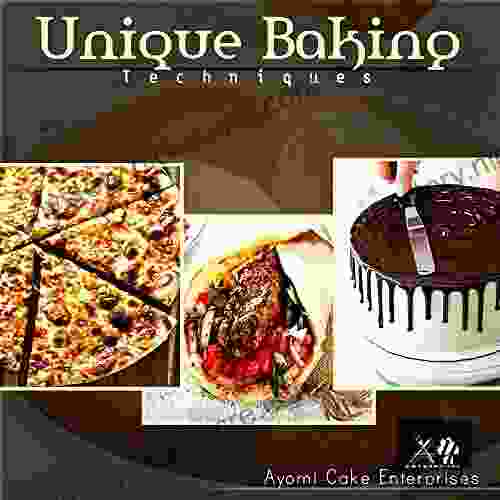
 Henry David Thoreau
Henry David ThoreauHow To Bake In Unique Way: Unleash Your Culinary...
Baking is an art form that transcends the...
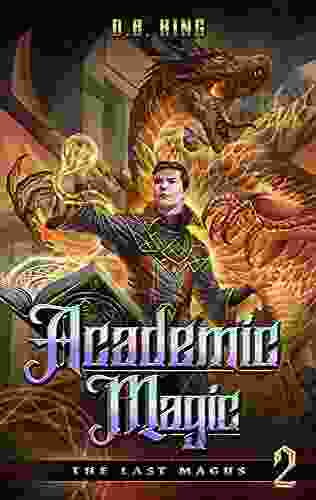
 F. Scott Fitzgerald
F. Scott FitzgeraldAcademic Magic: Unveil the Secrets of The Last Magus
Delve into a Realm of...

 John Green
John GreenThe Digitally Agile Researcher in UK Higher Education:...
In the rapidly...

 George Orwell
George OrwellZinc: Sources And Significance To Human Health
Zinc, an essential trace mineral, plays a...
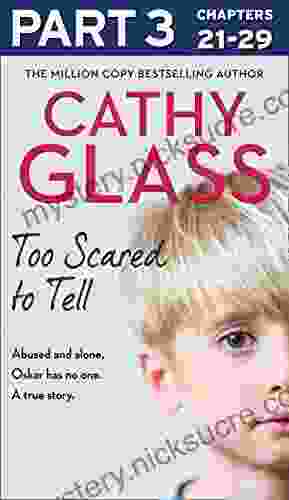
 Mario Simmons
Mario SimmonsToo Scared to Tell: A Harrowing and Thought-Provoking...
In the realm...
4.7 out of 5
| Language | : | English |
| File size | : | 52377 KB |
| Text-to-Speech | : | Enabled |
| Screen Reader | : | Supported |
| Enhanced typesetting | : | Enabled |
| Print length | : | 353 pages |


